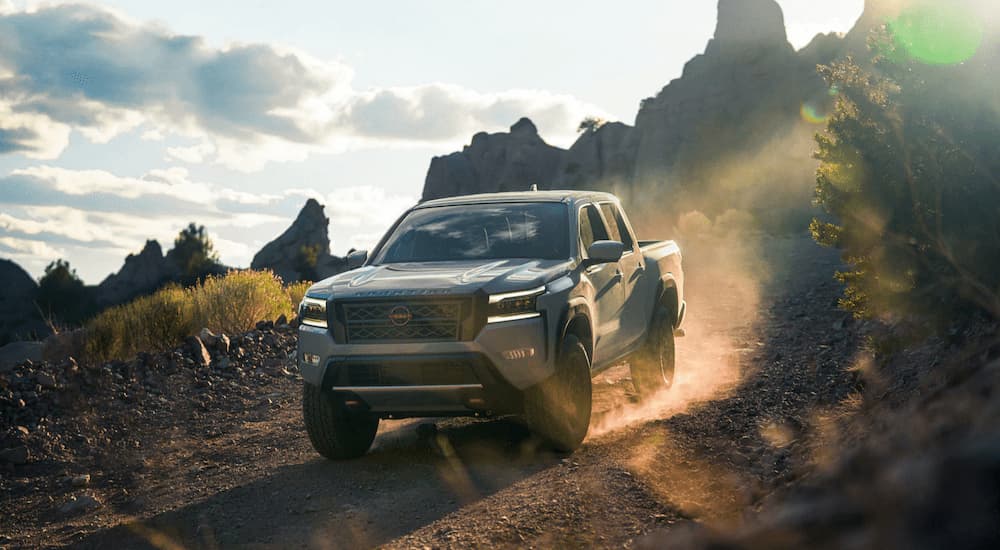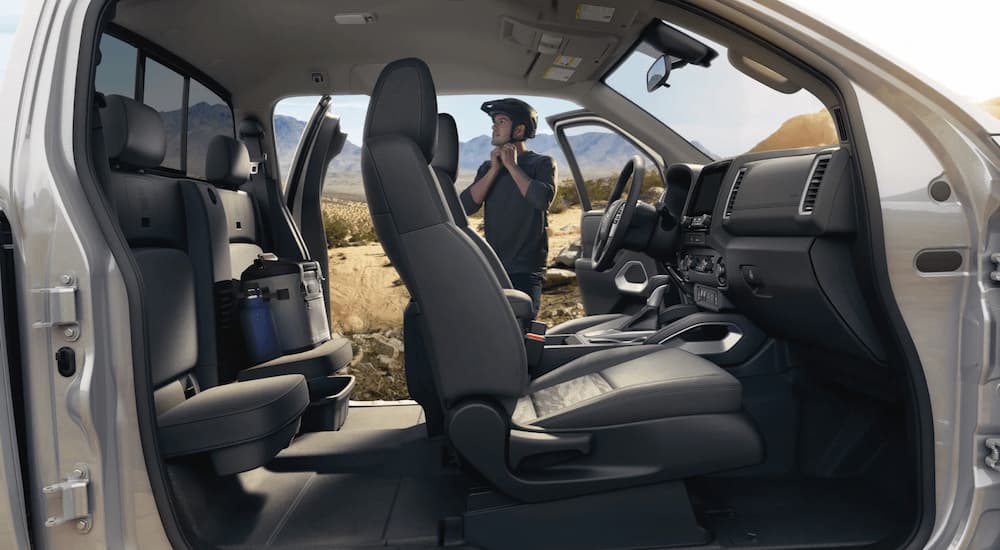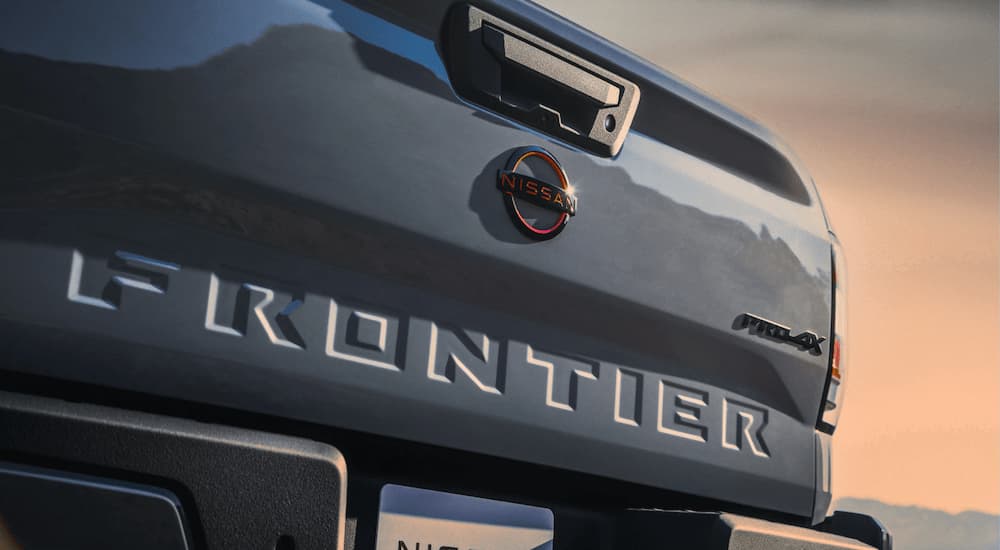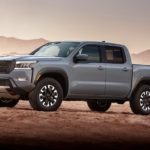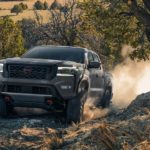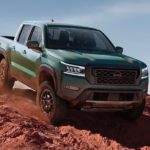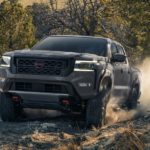Since its debut in 2005, the Nissan Frontier has delivered the type of consistent, reliable performance that’s so important in the mid-size pickup category. That said, the model had begun to look a little outdated in the last few years, with Nissan largely sticking to the same formula it had used for much of the past decades. That all changed in 2022 with the debut of the third-generation Frontier, which saw the model receive a complete overhaul.
One trip to your local Nissan Frontier dealer will prove just how far the pickup has come, doubling down on what it does best while adding some much-appreciated features to boot. These changes allow the Nissan Frontier to stay competitive in the hotly contested mid-size pickup market, which has quickly become the new battleground for automakers catering to those looking for a more practical alternative to the crossover SUV. Let’s look at some of the features that set the Frontier apart, starting with the goods under the hood.
Power Comes Standard
The 2023 Nissan Frontier immediately distinguishes itself from the pack when it comes to power. While large V6 and even V8 engines might be standard in the full-size pickup segment, the mid-size market has historically trended a little smaller, with turbocharged four-cylinder engines becoming the standard across much of the category. This might make sense from an efficiency perspective, but for those looking to maximize their pickup’s potential, it can be a little underwhelming when it comes to towing and payload capacity, not to mention fun.
In this respect, the 2023 Frontier is a breath of fresh air. Nissan’s marquee mid-size pickup is one of only three models in the category to come standard with a V6. No costly upgrades to increase power here: the V6 is not only the standard offering for the current model, but it’s also the only one available and pairs well with the pickup’s nine-speed automatic transmission.
Some drivers might want to ding Nissan for lack of customization potential, but it speaks to the automaker’s faith in the 3.8-liter, which has the numbers to justify its status as the sole engine offering. The nine-speed transmission also gives the Frontier some impressive fuel economy ratings for the category, with plenty of available shift points allowing the pickup to achieve 18 MPG in the city and 24 on the highway in rear-wheel drive mode, and 17 MPG in the city and 22 on the highway when opting for a 4WD model.
Trucks in the mid-size category tend to average between 160 and the high-200s when it comes to horsepower, but Frontier is a clear standout with a best-in-class 310 hp engine that blows away the competition. The mid-size pickup also excels when it comes to torque, once again coming out at the top of the class with 281 lb-ft that leads all V6 offerings. Between its class-leading horsepower and torque, it’s little surprise that the Frontier also ups the bar when it comes to towing and hauling capacity.
When equipped with the King Cab in 4×2 mode, the Frontier claims a towing capacity of up to 6,720 lbs. Those numbers drop a bit when opting for the Crew Cab Long Bed 4×4 version of the pickup, but it will still meet even the most demanding driver’s towing needs with a total capacity of 6,260 lbs. The Frontier is also packed with all the cutting-edge tech it takes to ensure each towing job is an unmitigated success, with features like a trailer hitch monitor, sway control option, and tow-haul mode that tweaks the transmission to prevent gear slippage. It’s an improved version of a good old-fashioned construction method that sets the pickup apart when it comes to towing, hauling, and off-road performance, so let’s explore that next.
Building a Better Frame
Unibody construction has been all the rage in the auto market as of late. While it offers some serious benefits in terms of comfort and efficiency, it doesn’t translate to some of the heavier-duty jobs we expect from the pickup segment. The approach works well for many SUVs, and while it has made its way into a growing number of compact and mid-size pickups in recent years, it can hinder both towing capacity and off-road performance. The Nissan Frontier is built with a full-length, fully boxed ladder frame featuring welded crossmembers and super-high-tensile-strength steel that’s stronger than conventional steel, but why is this so important?
Ladder frame or “body-on-frame” construction is simply a much more robust approach to vehicle design, featuring a solid frame that’s ideal for withstanding the excessive twisting forces that come with heavy-duty usage. This type of twisting stress isn’t a big concern for regular on-road driving, but as soon as you start exploring off-road trails, it can become important in a hurry. When an off-road vehicle’s tires leave the ground, the chassis wants to bend, which can cause some potentially costly damage as the shocks and suspension begin to wear unevenly. Ladder frame vehicles are much less susceptible to this type of damage due to their solid construction and high-strength materials, which can navigate even the most ridiculous angles with minimal flex.
The high-strength steel mix used in body-on-frame vehicles aids in durability and corrosion resistance and is also a standout when it comes to shock absorption. This is especially important in off-road scenarios where a long day of navigating rocks, ruts, fallen trees, and boulders can take a toll on overall driver comfort. Ladder frame vehicles are not only cheaper to produce but are also easier to repair given the more modular nature of their construction. Any serious damage to a unibody vehicle can lead to an expensive, complicated repair, as the whole body is often compromised, but not so with body-on-frame vehicles like the Frontier. Different parts can be easily replaced with minimal fuss, making it easy to switch out managed components or even the entire body should the need arise.
Again, ladder frame construction is largely the norm when it comes to the pickup segment, but the Frontier still has one major advantage over some of its competitors: a fully-boxed frame. In the pickup world, frames follow one of two basic designs: C-channel and full-boxed frames. In basic terms, a C-channel frame is one where the frame is open on one of four sides, while a full-boxed frame has all four sides enclosed, creating a rectangular box.
While Japanese automakers have embraced the fully-boxed approach for decades, the American market is just now catching up with brands like Ford steadily integrating the fully-boxed approach over the last few years. While C-channel construction doesn’t offer more flex and, therefore, comfort, it has quickly become outdated as drivers begin to expect more in the way of off-road performance from their vehicles.
The hydro-forming technique used in the Nissan Frontier’s fully-boxed approach has allowed the automaker to create a pickup frame with thinner walls and high-pressure steel, which reduces overall weight without sacrificing rigidity and strength. This technology is especially welcomed in the off-road-focused Frontier Pro-4X model, which used this robust construction approach as a base on which to build one of the segment’s most capable off-road models in recent memory. Complete with electronic locking differentials, Bilstein off-road shocks, and underbody skid plates; the Frontier Pro-4X is also a bargain with a relatively modest starting price of just north of $40,000.
Built to Handle the Challenges of Off-Roading
No matter which model you choose, the Nissan Frontier makes a strong case for itself within the mid-size pickup segment. Between its unprecedented power, heavy-duty construction, and towing prowess, the Frontier is a worthy entrant in the always-competitive category. The pickup’s fully-boxed frame sets it apart, upping the Frontier’s off-road credentials without dramatically increasing weight or sacrificing comfort. The Pro-4X model continues to improve with each model year, adding a host of impressive off-road components and some aggressive, sporty styling.
The Frontier also excels when it comes to integrating the latest in next-generation safety features, with a generous complement of safety-minded tech that’s built on Nissan’s Safety Shield 360 system. That’s a good showing for a pickup starting at just over $30,000, but there are also upgrades aplenty with the Convenience and Technology packages adding adaptive cruise control, blind-spot monitoring, rear cross-traffic alert, rear automated emergency braking, heated front seats and steering wheel, a trailer hitch and a spray-in bed liner. If the current model is any indication, Nissan could be making a play for the mid-size crown in years to come.
